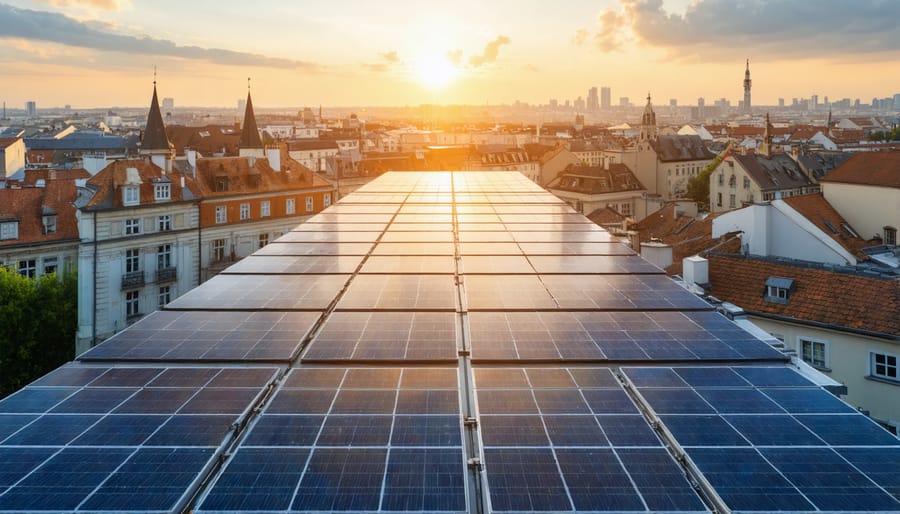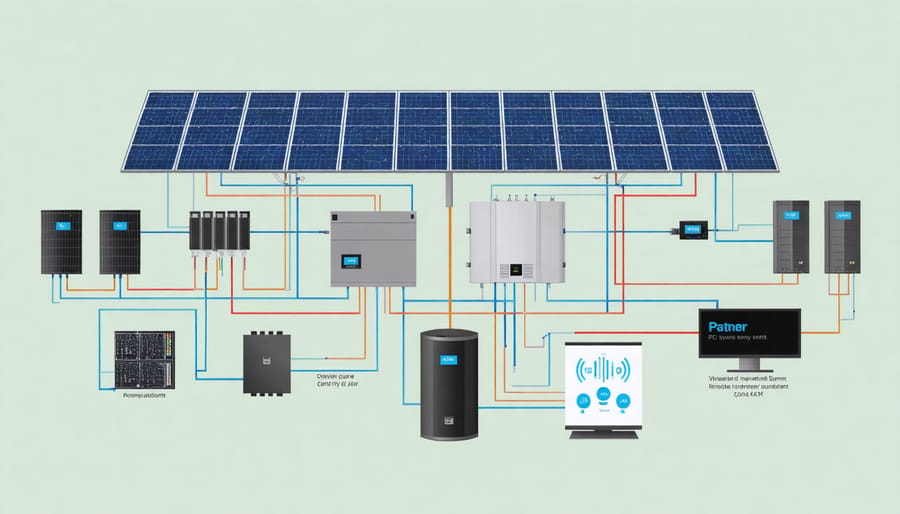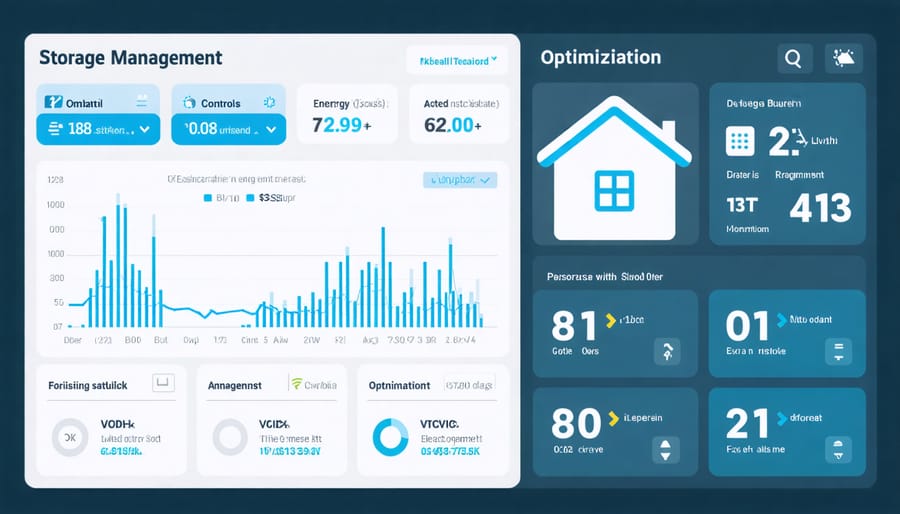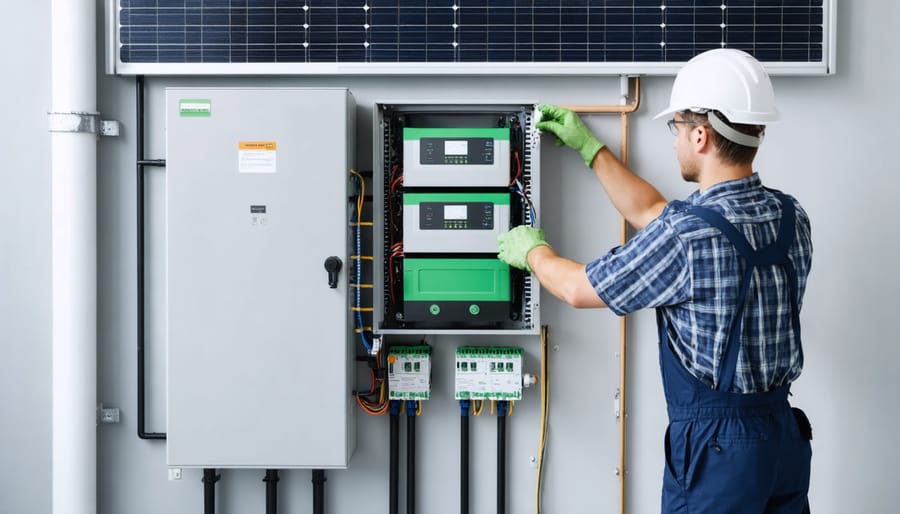PV Energy Storage Systems: Powering Europe’s Solar Revolution

Revolutionizing solar energy utilization, PV energy storage systems represent the cornerstone of modern renewable energy management, enabling households and businesses to maximize their energy independence while contributing to Europe’s sustainable future. These integrated solutions combine photovoltaic panels with advanced battery technology, transforming intermittent solar power into a reliable, round-the-clock energy source.
As energy costs continue to surge across European markets, PV storage systems offer a compelling solution by capturing excess solar production during peak hours and releasing it when needed most. This sophisticated technology not only reduces dependency on the grid but also provides critical backup power during outages, ensuring uninterrupted operations for businesses and peace of mind for homeowners.
The latest generation of PV storage systems incorporates smart energy management features, allowing users to optimize their energy consumption patterns through real-time monitoring and automated control systems. With technological advancements driving efficiency improvements and cost reductions, these systems have evolved from luxury investments to practical necessities in the modern energy landscape, offering both environmental benefits and significant financial returns through reduced utility bills and potential energy trading opportunities.
Understanding Modern PV Energy Storage Systems

Essential Components
A PV energy storage system comprises three fundamental components that work in harmony to ensure efficient solar energy utilization. At its core, the battery system serves as the powerhouse, typically utilizing lithium-ion technology for optimal performance and longevity. Advanced battery management systems monitor and regulate charging cycles, temperature, and overall battery health.
The inverter technology forms the second crucial element, converting DC power from solar panels and batteries into usable AC power for homes and businesses. Modern hybrid inverters offer bidirectional power flow, enabling seamless switching between solar, battery, and grid power sources while maintaining stable energy supply.
The control technology represents the system’s brain, orchestrating power flow, monitoring performance, and optimizing energy usage patterns. Smart controllers integrate with home automation systems and can respond to real-time electricity prices, weather forecasts, and consumption patterns to maximize energy efficiency and cost savings. These components work together to deliver reliable, sustainable power while ensuring system longevity and optimal performance.
Integration with Solar Arrays
Modern PV energy storage systems seamlessly integrate with both new and existing solar installations through sophisticated power electronics and smart controllers. The integration process typically involves installing a battery system alongside the solar inverter, with additional components like charge controllers managing the flow of energy between panels, batteries, and your home’s electrical system.
For existing solar installations, retrofitting storage capabilities usually requires adding a battery-ready inverter or a separate battery inverter. These components ensure optimal power conversion and system compatibility while maintaining high efficiency levels. Smart monitoring systems track energy production, storage levels, and consumption patterns, enabling automated decisions about when to store or use solar energy.
The physical connection occurs at your property’s distribution board, where sophisticated switching mechanisms determine whether solar power should directly supply your needs, charge the batteries, or feed into the grid. This integration creates a flexible energy ecosystem that maximises self-consumption of solar energy and provides backup power during grid outages, enhancing your energy independence and system reliability.
Benefits for European Homes and Businesses
Energy Independence
PV energy storage systems represent a significant step towards achieving true energy independence for European households and businesses. By combining solar power generation with advanced battery storage technology, property owners can significantly reduce their reliance on the conventional power grid while maintaining a reliable energy supply.
The system allows users to store excess solar energy generated during peak sunlight hours for use during evenings, cloudy days, or grid outages. This self-consumption capability typically enables households to achieve 70-80% energy independence, with some advanced systems reaching even higher levels. For businesses, this translates into reduced exposure to peak electricity pricing and enhanced operational resilience.
Energy independence through PV storage also provides protection against rising utility costs, which have become increasingly volatile across European markets. By generating and storing their own clean energy, system owners can effectively lock in their electricity costs for years to come, creating predictable energy expenses for better financial planning.
The flexibility of modern storage systems allows users to optimise their energy consumption patterns, drawing from stored power during high-tariff periods and charging during low-tariff times. This smart energy management approach, combined with real-time monitoring capabilities, enables users to maximise their investment while maintaining a reliable power supply that meets their specific needs.
Smart Energy Management
Modern PV energy storage systems leverage advanced technology to maximize energy efficiency and cost savings through sophisticated smart energy optimization features. These intelligent systems continuously monitor energy production, consumption patterns, and storage levels to make real-time decisions about energy flow management.
Using artificial intelligence and machine learning algorithms, these systems can predict household energy needs based on historical usage data, weather forecasts, and time-of-use electricity rates. This predictive capability enables automatic adjustments to charging and discharging cycles, ensuring optimal battery utilization while maintaining backup power reserves.
The integration of smart monitoring platforms allows system owners to track performance through user-friendly mobile apps and web interfaces. These platforms provide detailed insights into energy generation, consumption, and storage metrics, empowering users to make informed decisions about their energy usage.
Advanced features include automated peak shaving, which reduces electricity costs by drawing from stored energy during high-rate periods, and grid services participation, where excess stored energy can be sold back to the grid at premium rates. Some systems also incorporate smart home integration, allowing seamless coordination with other household devices to maximize energy efficiency.
For businesses, these management systems can be scaled to handle complex operations, multiple storage units, and integration with building management systems, providing comprehensive energy control solutions.

Installation and Integration Considerations
System Sizing and Planning
Determining the optimal size for your PV energy storage system requires careful consideration of several key factors. Start by analyzing your daily energy consumption patterns through recent electricity bills or monitoring devices. For European households, typical daily consumption ranges from 8-15 kWh, though this varies significantly based on location and lifestyle.
Consider your peak energy demands and when they occur. If your highest usage is during evening hours, you’ll need sufficient storage capacity to bridge this gap. Factor in seasonal variations, particularly important in European climates where solar generation can drop significantly during winter months.
A general rule of thumb suggests sizing your storage system to cover 50-80% of your daily energy needs. For most residential installations, this translates to storage capacities between 5-15 kWh. However, business applications may require larger systems, often 20 kWh or more, depending on operational requirements.
Future-proofing is essential – consider potential increases in energy consumption from electric vehicle charging or home expansions. Remember that oversizing can be costly, while undersizing may limit the system’s effectiveness. Professional assessment is recommended for precise sizing calculations.

Professional Installation Requirements
Professional installation of PV energy storage systems requires certified expertise to ensure safety, optimal performance, and compliance with European regulations. Qualified installers must hold relevant certifications such as electrical work permits and specific PV installation credentials recognised within the EU framework.
The installation process demands thorough site assessment, including structural evaluation of the mounting location, electrical system compatibility checks, and precise battery placement planning. Installers must consider ventilation requirements, temperature control, and protection from environmental factors when positioning storage components.
Critical technical considerations include proper cable sizing, protection device selection, and integration with existing electrical infrastructure. Installation teams need to implement appropriate safety measures, including surge protection, emergency shutdown systems, and proper earthing arrangements.
European standards mandate that installations comply with specific guidelines, including EN 62109 for power conversion equipment and IEC 62619 for battery safety. Regular maintenance protocols must be established, and monitoring systems should be properly configured during installation to ensure long-term system reliability.
Professional installers should also provide comprehensive documentation, including warranty information, operational manuals, and emergency procedures, ensuring end-users can safely manage their systems.
Maintenance and Monitoring
Regular maintenance and systematic monitoring are crucial for maximizing the lifespan and efficiency of your PV energy storage system. Implementing a comprehensive battery monitoring and maintenance schedule ensures optimal performance and early detection of potential issues. Key maintenance tasks include regular inspection of battery connections, cleaning of system components, and verification of proper ventilation in storage areas.
Modern storage systems come equipped with smart monitoring capabilities that track performance metrics such as charge cycles, depth of discharge, and overall system efficiency. These intelligent features allow system owners to optimize energy usage patterns and predict maintenance needs proactively. It’s recommended to conduct quarterly professional inspections alongside daily automated monitoring.
Documentation of system performance and maintenance activities helps track long-term trends and supports warranty claims when needed. Many European providers offer remote monitoring services, providing real-time alerts and performance analytics to ensure your investment maintains peak efficiency throughout its operational life.
Future-Proofing Your Solar Investment
Next-Generation Storage Technologies
The landscape of solar energy storage is rapidly evolving, with several emerging storage technologies poised to revolutionise how we capture and utilise solar power. Solid-state batteries are leading this transformation, promising enhanced safety and energy density compared to traditional lithium-ion solutions. These innovative batteries eliminate liquid electrolytes, reducing fire risks and extending operational lifespans significantly.
Flow batteries represent another breakthrough, offering scalable storage solutions particularly suitable for large-scale industrial applications. Their ability to separate power and energy capacity makes them highly adaptable to varying energy storage needs. European researchers are also making significant progress with sodium-ion batteries, which could provide a more sustainable and cost-effective alternative to current technologies.
Hydrogen storage systems are gaining traction as a long-term storage solution, especially for seasonal energy shifting. When combined with solar PV systems, these technologies can convert excess solar energy into hydrogen for later use, addressing intermittency challenges effectively.
Metal-air batteries and advanced thermal storage solutions are also showing promise, with several pilot projects across Europe demonstrating their potential for both residential and commercial applications. These innovations focus on improving efficiency, reducing costs, and enhancing the integration of renewable energy into existing power grids.
Smart Grid Integration
Smart grid integration represents a crucial advancement in modern PV energy storage systems, enabling bidirectional communication between your solar installation and the broader power network. This intelligent connectivity allows your system to respond dynamically to grid conditions, optimise energy flows, and participate in demand response programmes across Europe.
Modern PV storage systems come equipped with smart inverters and sophisticated control systems that enable automated grid services. These features help stabilise the local grid by managing voltage levels and frequency regulation, while also providing valuable grid support during peak demand periods. For system owners, this translates into potential revenue streams through grid services and enhanced energy management capabilities.
The integration process typically involves advanced monitoring systems that provide real-time data on energy production, consumption, and storage levels. This data enables intelligent decision-making about when to store, use, or feed energy back to the grid, maximising both financial returns and system efficiency.
European grid codes and standards are continuously evolving to accommodate the growing presence of distributed energy resources. Modern PV storage systems are designed to be future-ready, with firmware updates ensuring compliance with new regulations and grid requirements. This forward-thinking approach protects your investment while contributing to Europe’s renewable energy transition.
For optimal grid integration, your system should include features like remote monitoring capabilities, automatic grid synchronisation, and islanding protection, ensuring seamless operation whether connected to or isolated from the main grid.
As we look towards a more sustainable energy future, PV energy storage systems stand as a cornerstone of modern power management solutions. These innovative systems have proven instrumental in addressing the intermittent nature of solar power generation while offering unprecedented control over energy consumption and costs. For European homeowners and businesses, the integration of storage solutions with photovoltaic systems has transformed the way we think about energy independence and grid reliability.
The growing adoption of PV storage systems across Europe reflects their crucial role in achieving climate goals and energy security objectives. By enabling users to store excess solar energy for later use, these systems maximize the value of renewable investments while contributing to grid stability. This capability has become increasingly important as regions work to balance variable renewable energy sources with consistent power demands.
The technology continues to evolve, with advances in battery chemistry, smart management systems, and integration capabilities making storage solutions more efficient and cost-effective. For European stakeholders, these improvements translate into better returns on investment and enhanced energy autonomy. The ability to participate in emerging energy markets, such as demand response programs and virtual power plants, further amplifies the economic benefits of storage systems.
Looking ahead, PV storage systems will play an essential role in Europe’s transition to a carbon-neutral economy. As grid modernization efforts continue and renewable energy penetration increases, the flexibility and reliability offered by storage solutions become increasingly valuable. For both residential and commercial users, investing in PV storage represents not just a practical energy solution, but a commitment to sustainable development and energy resilience.
Leave a Reply